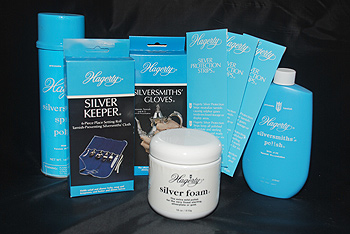



    |
 |
Cleaning and Proper Storage of Silver One of the pleasures of owning antique silver is its “patina,” the beautiful luster that silver acquires with the passage of time and the acquisition of numerous minute scratches on its surface. Maintaining the luster has, however, been regarded as one of the drawbacks of owning silver. If an antique object of silver has not been mistreated, the patina is protected by a layer of “onion skin.” It is important to protect this layer, as patina is almost an infallible guide to original condition.1 Tarnish, the natural and inevitable process of oxidation, depends on the amount of moisture and pollutants in the atmosphere. Objects, not on display, can be kept in a tarnish proof bag (available from department stores). Silver can also be stored by wrapping the article in acid-free tissue paper, and placing it in a plastic bag. Silver should not be allowed to touch the plastic film directly, as some brands can permanently discolor the silver.2 Silver objects on display in a closed cabinet can be protected by use of “silver strips” which neutralize tarnish-causing sulphur gases. These strips can protect as long as six months. We definitely endorse these. prada tights get chatgpt prada cat eye outlet cheap clothes prada snakeskin bag prada bag repair prada necklaces instagram followers 1 pink prada slides clutch bag prada prada swim shorts جوتشي official prada website prada arca lyrics prada colors cardinal supply st.louis tuscany rosemont bondy bait chatgpt 原理 lebron instagram followers chatgpt llm captain epaulettes but instagram followers the mosaic company tampa fl mike prada lentes prada originales neymar instagram followers Most tarnish can be wiped off with a soft cloth, and can be cleaned with “silver foam,” which has no abrasives. Silver foam differs from cleaners containing pumice or chalk, and is therefore preferred, as it will not cause the deterioration of the “onion skin.” Some preparations also contain non-toxic tarnish inhibitors, which keep silver clean for up to three times longer than similar products without inhibitors.  Please contact us if you are unable to locate these fine products near you. 2 Derbyshire, Lydia, Antique Silver, The New Compact Study Guide and Identifier, London, 1994, p. 11.
|
|||||